Scientists predict warmer and wetter Himalayas

KATHMANDU,Nepal-Water levels of the critical rivers that originate in the Himalayan glaciers will not drop over the next century, predict scientists.
The latest research led by Dr Walter Immerzeel, a scientist from Utrecht University in the Netherlands and visiting scientist at the International Centre for Integrated Mountain Development (ICIMOD) in Nepal, indicates that increasing rains would prevent rivers from drying up. His earlier works, published in Science in June 2010,indicated worrisome drop in the levels of the same rivers by 2050.
New results from Dr Immerzeel’s research indicate that water levels of the rivers will not drop over the next century due to an increase in monsoon rains in the region. However, climate change will result in smaller glaciers and less meltwater in the Himalayas. The research shows that although the size of the glaciers in the basins of the Indus and the Ganges will decrease in the 21st century, water discharge will however increase.
While the results of the research predict a sombre future for the Himalayan glaciers, they offer some good news for water and food security in India, Bangladesh, and Pakistan. The rivers in the Himalayas, such as the Indus and the Ganges whose waters depend on the melting of glaciers and snow, are essential to the food supply of hundreds of millions of people in the lower-lying areas.
Therefore, understanding the impact of climate change on the glaciers in upstream areas plus snowmelt and monsoon patterns is crucial.
“We are now using a more advanced glacier model that takes into consideration how slowly glaciers respond to climate change,” explains Dr Immerzeel. “The key difference is that previous work by our group and other scientists showed that the extent to which precipitation inthe western Himalayas increases with altitude is much greater than we previously thought. The computer model used for this research takes these new insights into consideration.”
To understand the impact of climate change on river discharge in the Himalayas, the researchers created computer models of the glacier movements and water balance in two watersheds that vary greatly with regard to the climate and size of the glaciers.
In the eastern watershed (Langtang in Nepal, where the Ganges has its source), the relatively smaller glaciers melt quite quickly, and the increased water discharge is a result of the increase in monsoon
rains. The western watershed (Baltoro in Pakistan, where the Indus has its source), on the other hand, is dryer and colder and has much larger glaciers. The increase in discharge in the basin there is due to increased glacial melting.
According to the study, glacial melting will hit the peak somewhere around 2070 and the glacial discharge will start to drop. However, at that time too the increase in precipitation will compensate for this, as a result of which the annual discharge from the river basin will increase again.
The researchers, however, emphasize that the results should be interpreted with caution.
“The research concerns two basins, and while the models are representative they only relate to a small area of the Himalayas,” says Glaciologist Francesca Pellicciotti of ETH Zürich, a science and technology university in Switzerland and also a visiting scientist at ICIMOD. “Furthermore, we concentrated on the impact on averagedischarge, rather than extremes.”
The Regional Programme Manager at ICIMOD, Arun Shrestha, says the results very much depend on the climate scenarios used for the analysis and available scenarios have high uncertainties in projecting monsoon precipitation but do provide scope for improvement in the future.
Director General of ICIMOD, Dr David Molden, says this important research challenges perception of the impact on climate change on water resources. “However much work remains, including better understanding of changes in monsoon patterns and snowmelt, and resulting variability in river flows, including low flows and flood peaks.”
Dr Immerzeel conducted his study in collaboration with ETH Zürich and Deltares, an independent institute for applied research in the field of water, subsurface, and infrastructure based in the Netherlands.
ICIMOD is collaborating with Dr. Immerzeel and Francesca Pellicciotti under its Cryosphere Monitoring Programme and some of the research results are the outputs of this collaboration.

